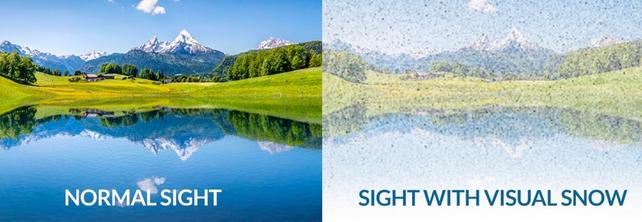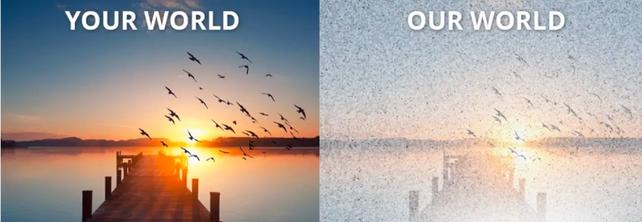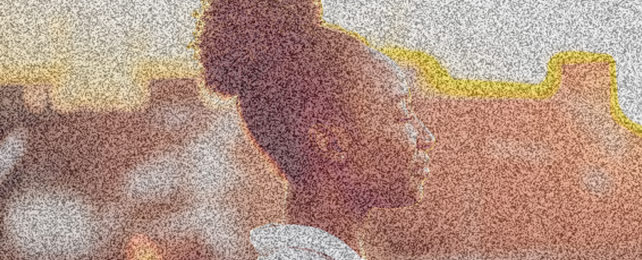This as-told-to essay is based on a conversation with Sierra Domb, founder and CEO of the Visual Snow Initiative, about her journey with visual-snow syndrome – a neurological condition where people see tiny, snow-like flecks in their vision. It has been edited for length and clarity.
One day in 2015, as I was driving to university, my vision went black. My vision returned moments later, but the world didn't look the same after that.
It was like a veil was covering my eyes – like I was seeing the world through an analog TV static. More symptoms began, including extreme light sensitivity and palinopsia, or when you continue to see an image after it's no longer there. I also experienced ringing in the ears and recurring migraines.
From there, I went to some of the most well-known medical institutions in the country. After about 18 months of uncertainty and seeing many physicians, I was left without an answer as to what was going on with me.
Then, I discovered the name visual-snow syndrome in an online medical journal. The symptoms described in the article matched my symptoms exactly. I immediately contacted the doctor who wrote the article, and he subsequently diagnosed me with visual-snow syndrome.
Visual-snow syndrome is a neurological condition with a constellation of visual and non-visual symptoms. The hallmark symptom is seeing static or clashing lights and flickering dots that obstruct your vision 24/7, whether your eyes are open or closed.

I learned that this syndrome was not well known within the medical community.
There were countless people out there, like myself, that were left to deal in private with this condition. A lot of people end up online, speculating what's wrong with them, and they have to self-diagnose.
People like me were being marginalized and left without resources, simply due to lack of awareness and education. I sought out to rectify this by starting the Visual Snow Initiative – a nonprofit that raises awareness, provides education, offers resources, and facilitates worldwide research as well as potential treatments for visual-snow syndrome.
We created the first diagnostic criteria for visual-snow syndrome, so basically anyone in the world can show it to their doctor to confirm a possible diagnosis. We also created a worldwide directory of physicians and specialists with knowledge of visual snow.
Oftentimes, people with visual-snow syndrome go to an eye doctor.
They see an optometrist or an ophthalmologist, which are doctors who specialize in the eye, and their test results come back normal, because there's nothing wrong structurally with their eyes.
Research has found out that that visual-snow syndrome is a neurological disorder, meaning that it's processing centers in the brain impacting your vision.

It's become apparent that this is not as rare as people initially thought.
When I first experienced the onset of visual-snow syndrome, I wasn't even aware there were other people out there who had it too. Researchers have discovered it may affect an estimated 2 percent to 3 percent of Earth's population. That percentage may seem small, but to put it in perspective, that's millions of people who are affected all around the world.
Additionally, my team and I have communicated with thousands of people who have visual snow in over 93 countries. People of all ages and all backgrounds can be – and are – affected daily.
When you have a large population of people that are also born with visual snow, they may not even know they have symptoms. They might think everybody sees the world this way. Those cases might go under-reported.
Everyone's visual snow is different.
People with visual snow may experience all or only a few symptoms, including light sensitivity and tinnitus. These symptoms range in severity from mild to debilitating.
Living with this condition is a different experience for everyone.
When I first experienced visual snow, it was debilitating. Over time, it's improved. For some people it's mild from the start, and it doesn't affect their daily life, and for some people it does. Many function normally, and for others it can be life-altering.
The one defining commonality for everyone with visual-snow syndrome is that they do see static 24/7, whether your eyes are opened or closed.

People might link their visual snow to a specific incident.
When you get a concussion, is this what caused your visual snow? Was it X? Was it Y?
There's been a lot of speculation about the root cause, and the reality is that there are a lot of different reasons that people attribute to their visual snow, and it can be difficult to pinpoint across the board something that everyone has in common, especially when you have people that are born with something, and then people who get it at a random point.
You will find commonalities across the board, but that doesn't mean that every single person with visual-snow syndrome has had the same experience, or it was brought on by the same exact thing.
To date, researchers are not aware of a cure for visual-snow syndrome.
Part of my mission with the Visual Snow Initiative is to rectify that. I was told by experts and researchers that this is something that will take time, but we've made tremendous strides in a short period of time.
Two doctors we collaborate with have had tremendous success helping visual snow patients treat some of their symptoms with Neuro-Optometric Rehabilitation Therapy, or NORT. It addresses the visual symptoms and some of the non-visual ones, as well.
Wearing FL-41 tinted glasses might also be helpful.
This article was originally published by Business Insider.
More from Business Insider: